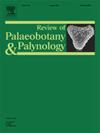Relationships between pollen assemblages and modern vegetation of the southern Gaoligong Mountains region, southwest China
IF 1.7
3区 地球科学
Q2 PALEONTOLOGY
引用次数: 0
Abstract
Comprehensive understanding of the modern pollen–vegetation relationship is crucial for utilizing fossil pollen to reconstruct palaeovegetation, especially in mountainous areas of southwestern China. In this study, we present forty-five modern surface samples collected from five different vegetation communities of the southern Gaoligong Mountains region, and the vegetation composition was investigated at each sample site. The modern pollen assemblages were analyzed through multivariate analysis to evaluate the relationships between vegetation types and pollen assemblages, and to investigate the representation of major pollen types in different vegetation types. The results indicate that the surface pollen assemblages of different vegetation types reliably represent the modern vegetation. The median R-values of dominant pollen taxa in the Gaoligong Mountains region can be ordered as follows: Pinus > Alnus > Poaceae > evergreen Quercus. The over-representation of Pinus pollen, attributed to its high productivity and strong dispersal ability, makes it the dominant component of exotic pollen. Conversely, the under-representation of evergreen Quercus suggests that the presence of its pollen within a sample might indicate the growth of the local parent plant in the study area. The human activities in the region have a recognizable effect on the surface pollen spectra and also exert a significant negative impact on pollen diversity. Our study supplements the modern pollen database of the mountain regions in southwestern China, and provides representative modern pollen analogues to interpret fossil pollen records from southwestern China and similar regions.
中国西南高黎贡山南麓地区花粉组合与现代植被的关系
全面了解现代花粉与植被的关系对于利用花粉化石重建古植被至关重要,尤其是在中国西南山区。本研究从高黎贡山南部地区的五个不同植被群落中采集了 45 个现代地表样本,并对每个样本点的植被组成进行了调查。通过多元分析对现代花粉组合进行了分析,评估了植被类型与花粉组合之间的关系,并研究了主要花粉类型在不同植被类型中的代表性。结果表明,不同植被类型的地表花粉组合可靠地代表了现代植被。高黎贡山地区主要花粉类群的 R 值中位数排序如下松科(Pinus >)、桤木科(Alnus >)、禾本科(Poaceae >)、常绿柞树科(Quercus)。由于松科花粉产量高、传播能力强,因此在外来花粉中占主导地位。相反,常绿柞树花粉所占比例较低,这表明样本中出现常绿柞树花粉可能表明研究地区当地母本植物的生长情况。该地区的人类活动对地表花粉光谱有明显的影响,也对花粉多样性产生了显著的负面影响。我们的研究补充了中国西南山区的现代花粉数据库,为解释中国西南及类似地区的花粉化石记录提供了具有代表性的现代花粉类比。
本文章由计算机程序翻译,如有差异,请以英文原文为准。
求助全文
约1分钟内获得全文
求助全文
来源期刊
CiteScore
3.50
自引率
21.10%
发文量
149
审稿时长
6 months
期刊介绍:
The Review of Palaeobotany and Palynology is an international journal for articles in all fields of palaeobotany and palynology dealing with all groups, ranging from marine palynomorphs to higher land plants. Original contributions and comprehensive review papers should appeal to an international audience. Typical topics include but are not restricted to systematics, evolution, palaeobiology, palaeoecology, biostratigraphy, biochronology, palaeoclimatology, paleogeography, taphonomy, palaeoenvironmental reconstructions, vegetation history, and practical applications of palaeobotany and palynology, e.g. in coal and petroleum geology and archaeology. The journal especially encourages the publication of articles in which palaeobotany and palynology are applied for solving fundamental geological and biological problems as well as innovative and interdisciplinary approaches.

 求助内容:
求助内容: 应助结果提醒方式:
应助结果提醒方式:


